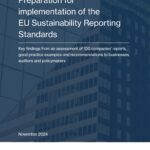
A materiality assessment is how you figure out which sustainability issues have the greatest risk or reward for your company. Most people who work on corporate responsibility or sustainability have done, or considered doing, some sort of materiality assessment . The process requires an assessment of a company’s social, environmental, and economic impacts and risks in the context of business goals.
Practitioners often use a materiality assessment to determine what to report to a wider range of stakeholders, not just shareholders. This may seem like a subtle distinction, but what gets reported to all stakeholders is quite different than what gets reported to shareholders. The threshold for “materiality” is not only tied to financial performance. It also reflects much wider interests and concerns. The Global Reporting Initiative (GRI) defines materiality assessment in the context of more general reporting.
Read the full article by Jennifer Anderson



